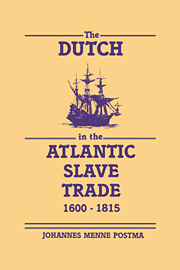Book contents
- Frontmatter
- Contents
- List of tables, figures, and maps
- Preface
- 1 Foundations of the slave traffic, 1600–61
- 2 Curaçao and the asiento trade, 1650–1730
- 3 The Dutch on the West African coast
- 4 Trade and politics on the African coast
- 5 Volume of African exports and origins of slaves
- 6 Organization and mechanics of the trade
- 7 The triangular trade
- 8 The Dutch plantation colonies under WIC monopoly, 1618–1738
- 9 The era of the free trade, 1730–80
- 10 The slaves: their treatment and mortality
- 11 Finances, marketing, and profitability
- 12 The end of the Dutch slave trade, 1781–1815
- Appendixes
- Bibliography
- Index
2 - Curaçao and the asiento trade, 1650–1730
Published online by Cambridge University Press: 16 September 2009
- Frontmatter
- Contents
- List of tables, figures, and maps
- Preface
- 1 Foundations of the slave traffic, 1600–61
- 2 Curaçao and the asiento trade, 1650–1730
- 3 The Dutch on the West African coast
- 4 Trade and politics on the African coast
- 5 Volume of African exports and origins of slaves
- 6 Organization and mechanics of the trade
- 7 The triangular trade
- 8 The Dutch plantation colonies under WIC monopoly, 1618–1738
- 9 The era of the free trade, 1730–80
- 10 The slaves: their treatment and mortality
- 11 Finances, marketing, and profitability
- 12 The end of the Dutch slave trade, 1781–1815
- Appendixes
- Bibliography
- Index
Summary
The loss of Brazil might have ended the Dutch participation in the slave trade had the WIC not been able to find new markets for its human merchandise. This was not an easy task, however. New Netherland, as discussed, offered little promise as a slave market; besides, the colony was taken over by the English in 1664. The profits in the traffic, however, were apparently sufficient to urge the company to search for new outlets, although the market reorientation was characterized by a short period of stagnation and experimentation.
Finding new markets was not the only problem for the WIC. The second half of the seventeenth century also saw several new competitors enter the Atlantic slave trade. English subjects took an active interest in the traffic shortly after the middle of the century and France became involved toward the end of the century. In addition, Danes, Swedes, and Germans from Hamburg and Courland entered the slave trade, albeit on a small scale. These minor participants, however, were supplied with capital and ships by Dutch investors and may therefore be counted as an extension of the Dutch slave trade. Portugal also reentered the slave trade by recapturing her old trading centers on the Angola coast in 1648. Only after peace was made between Holland and Portugal in 1661, ending many years of hostility, did the Dutch again become regular participants in the slave trade.
Notwithstanding all this competition, the Dutch maintained a foothold in the traffic.
- Type
- Chapter
- Information
- The Dutch in the Atlantic Slave Trade, 1600–1815 , pp. 26 - 55Publisher: Cambridge University PressPrint publication year: 1990
- 1
- Cited by



